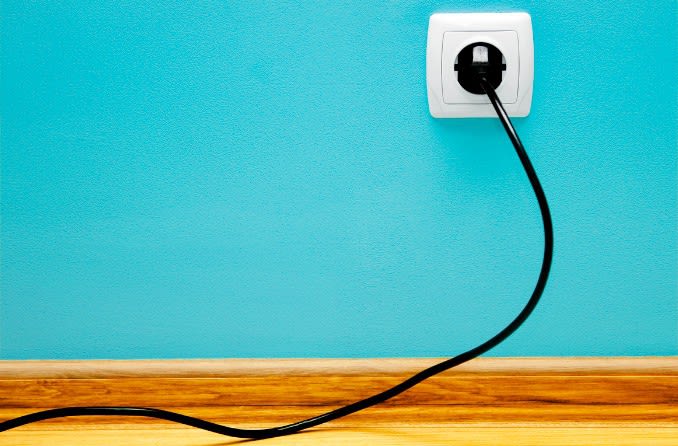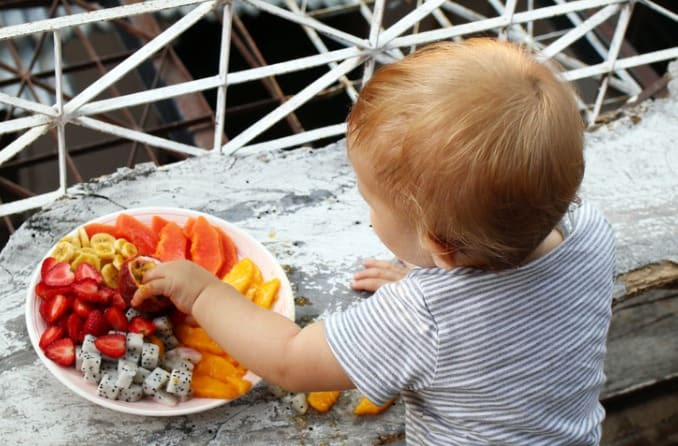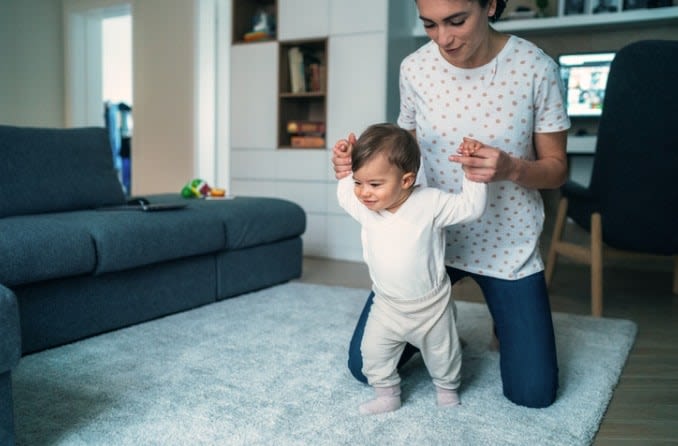A complete guide to “baby proofing” your home for a child with visual impairment

Watching your baby grow more independent as they develop the strength and mobility to get around on their own can be an exciting and terrifying experience for any parent. Often beginning before baby even comes home from the hospital for the first time, many parents are busy preparing their home and making sure it’s safe for a young child.
While there are many precautions taken to ensure any baby’s safety in the home, parents of a visually impaired child have an additional list of things to do to meet the special needs of their little one.
The following guide provides tips for childproofing your home for a visually impaired child and ways to help them safely explore their home.
Provide orientation and mobility training
Pairing your child with an orientation and mobility (O&M) specialist from a young age will help them build independence and confidence moving through life with visual impairment.
An orientation and mobility specialist can teach your child how to determine where they are and where they want to go. They also equip your child with the skills to safely and efficiently travel, both inside and outside the home.
While venturing outside the home may be better suited for older children and adults, O&M specialists also work with infants and preschool-aged children to:

Encourage purposeful movement and develop gross and fine motor skills
Train them to recognize different things they see, hear, smell or touch
Teach them about the purpose and movement of different body parts
Introduce ideas about the child’s surroundings, starting with the home
To master these skills, a child may work with an O&M specialist from infancy to young adulthood. These specialists can also help children become more comfortable in unfamiliar environments, such as a new school or day care. Adults with visual impairment also occasionally work with a specialist this way, for example, when moving to a new town or office for work.

Avoid stairs
As one would likely expect, stairs are not the safest thing to have when there’s a baby in the house, especially if the child is visually impaired. In fact, the American Academy of Pediatrics lists stairs as one of the top 10 most common sources of injury in toddlers and small children.
While the ideal suggestion is to not have stairs in the home at all and settle into a one-story home, doing so may not be possible or practical for all families. In homes with stairs, gates should be installed at the top and bottom of any staircases.
Gates being placed at the top of the stairs is a common way to prevent a child from crawling and falling down the stairs. However, placing a gate at the bottom of the stairs also prevents the child from trying to climb up the stairs and potentially falling back down them.
Once the child matures and can use the stairs safely, handrails and proper lighting should be installed along any steps or stairs in the house. This ensures safe navigation for your child, not to mention others who enter your home.

Provide proper lighting
According to Dr. Brandy Archie, Occupational Therapist and Founding Director of AccessAble Living, a company that provides seniors and disabled persons with the resources they need to live safely at home, lighting is key. However, not all lighting is good lighting for the visually impaired.
“The house should be equipped with the right lighting to meet your child’s needs,” Dr. Archie says. “For some diagnoses, glare is a problem. So, avoid bright light coming directly at the eyes, like from a sunny window.”
Besides glare, shadows cast from certain lighting can confuse someone with low vision. To reduce glare and shadows from natural light, hang sheer curtains over the windows or have adjustable shutters installed to control lighting level. For artificial lighting, consider overhead sources to reduce shadows.
Others with low vision, as Dr. Archie explains, will benefit from additional lighting to create better contrast and improve visual capability. Depending on what type of lighting your child prefers, this could mean installing windows or a skylight for extra natural lighting, or table lamps that allow them to focus the light in a specific direction.
It’s also important to provide proper lighting in high-traffic areas of the home, including the bathrooms, kitchen, stairs (if applicable) and hallways.
To determine what lighting is most appropriate for your child’s needs, Dr. Archie suggests having an occupational therapist evaluate the home and make suggestions on how to best accommodate your child.

Cover electrical outlets and hide or tape down any loose cords
Electrical outlet covers are useful for protecting your child from any electrical hazards in the home. An additional step to keep your child safe is to hide or secure any loose cords from lamps, phone chargers or other electronics.
Not only will this keep the child from getting tripped or tangled by the cord, plus keeping the wires hidden can prevent any pulling or chewing that may occur if they’re exposed.
Another related safety precaution for babies and small children is protecting them from the cord that adjusts your blinds. While cordless blinds are the new standard, older homes may still have blinds that use a cord to adjust the length.
If your home has corded blinds, the United States Consumer Product Safety Commission suggests that you replace them with the cordless kind. Accidents can happen even if you attempt to keep the cord out of the child’s reach.
Remove any smothering and choking hazards
Babies are known for putting everything they can get their hands on in their mouths, which increases their risk of choking.
Keep toys or household objects that are small enough to be swallowed out of your baby’s reach. You should also make sure the safe toys you give them are free of smaller parts that they can remove and swallow. Examples of this include the button on a doll’s dress or the plastic eye stitched onto a stuffed animal.
Other items that may interfere with your child’s ability to breathe include blankets, loose bedding, stuffed animals and pillows. For this reason, The American Academy of Pediatrics recommends having the child sleep on a firm sleeping surface that is covered only with a fitted sheet.
Have your baby sleep in a swaddle sack or sleepsuit to keep them warm without using a blanket.

Increase contrast
As mentioned, contrast is extremely helpful for people with low vision to read, see and understand where they are in the home, or to identify any nearby risks.
Use contrast in hazardous areas, including near steps or an incline/decline, or when there is a change in flooring, such as from carpet to tile. These are trip hazards and can easily cause falls if the child is not prepared for it.
While using brightly colored tape can alert change to a child, there are more subtle ways to accomplish this. For example, choose contrasting colors for variations in flooring, such as light colored carpet and dark hardwood. The child will learn that when the color of the flooring changes, so does the height and texture.
According to Dr. Archie, color contrast can help a child with nearly every task, including how they eat.

“Use high-contrast dishes so eating is easy and less likely to be messy,” she suggests. “A white plate is great for seeing the different colored foods but should be placed on a dark-colored table or place mat, so it's easy to find the edge of the plate.”
Dr. Archie also suggests using brightly colored forks and cups that stand out, though a number of visually impaired children also have some level of colorblindness, which should be taken into consideration.
Keep your pets’ food and water bowls off the floor
Before you let your baby crawl around and explore their home, pick up any pet food, water or toys from the floor. If your child comes across any of these items, you don’t want them playing in it or putting it in their mouth.
The same rules apply to a cat’s litter box: Keep it in a place where your child will not have access to it.

Limit patterns
What most may see as a beautifully intricate rug or trendy new tile can often appear as a jumbled mess to someone with low vision. Clear, crisp color contrast is easiest to see for the visually impaired — a characteristic that patterns rarely offer.
Dr. Archie explains that patterns can be disorienting to visually impaired children, which may cause falls or frustration with finding objects they have dropped or are trying to play with on a patterned floor.
Sticking with furniture and flooring that have solid contrasting colors will be the most helpful to your child while they toddle around the house.
Avoid tablecloths or runners
As babies learn to stand and walk, they often use items around the house to pull themselves up. A child may try to pull themselves up using the edge of a tablecloth, which can cause a vase, plates, hot food or silverware to fall on them.
To avoid any accidents or injuries, it’s suggested that you remove tablecloths and table runners that hang over the edge of the table.
Provide soft touch areas
Dr. Yuna Rapoport, Assistant Professor of Ophthalmology at Mount Sinai Icahn School of Medicine, suggests creating soft-touch areas around the home for children who are blind or have profound visual impairment.
“Have coverings over the corners of tables or on wall surfaces, where the child can feel their way around the home,” Dr. Rapoport explains.
You can achieve soft-touch areas using corner protectors or “bumpers” that are placed on sharp edges, including shelves, tables, dressers, etc. If there are walls in the home that create an outward corner, you can place bumpers along the corners to prevent the child from running into them and hurting themselves.
Creating soft-touch areas will be valuable to your child even as they grow into young adults, as they can work like checkpoints to inform them where they are in the home.
Tape down or remove rugs
Rug corners that turn up or get caught on various objects can be a tripping hazard for anyone, but are especially challenging for children with low vision. Secure the edges of all rugs with tape or sticking methods created specifically for rugs.
Putting non-slip pads beneath the rugs adds another layer of protection for your child and keeps the rug from slipping out from under them as they learn to walk.
Keep closet doors, cabinets and drawers closed
As your baby moves freely around the house, it’s important to keep doors, cabinets and drawers closed when they’re not in use. If your child becomes familiar with the layout of a room while the doors are closed, they will expect the doors to be closed at all times.
Leaving a drawer partially open or a closet door ajar could cause them to run into it, potentially injuring themselves.
When hosting guests, or if there are multiple members in the household, remind them to avoid leaving doors open as a safety measure.
Another way to keep your child safe is to childproof any cabinets or drawers that may have dangerous things in them, including cleaning supplies, bug spray, or kitchen gadgets, such as a blender or vegetable chopper.
Anchor furniture
Once again, babies often pull themselves up to stand by grabbing onto furniture. For this reason, it’s important to secure bookshelves, coffee tables and other furniture to ensure nothing will tip over onto the child as they learn to get around.
While the chances of a dresser, crib or bookshelf falling on top of your child may seem minimal, the number of accidents seen in recent years has sparked action among government organizations.
The U.S. Consumer Product Safety Commission started the Anchor It! campaign in September 2020 in response to a 2019 study by emergency departments across the country that reported around 26,000 television or furniture stability-related injuries each year, from 2016 through 2018.
The act of anchoring also applies to shelves and things hung up on the walls. Visually impaired children often use their sense of touch to navigate their environment. If pictures, paintings or other wall art are not anchored properly, they may fall on the child as they feel their way around.
Keep the home organized and consistent
When you live with a visually impaired child, keeping the floors clear of clutter and messes is key. Any unnecessary furniture, shoes, toys or other items left on the floors will become obstacles for the child to work around as they navigate the home.
Spills should be cleaned up immediately, as well as food that may accidentally fall on the floor.
As the child becomes familiar with the layout of the home, it is important to keep their environment consistent. For example, moving furniture around, or adding things such as a bookshelf or side table can confuse the child and require that they relearn their surroundings.
Orientation and mobility skills. VisionAware. Accessed April 2021.
Orientation and mobility for blind babies and toddlers. FamilyConnect. Accessed April 2021.
Safety pitfalls: Stairs are a leading cause of injury for small children. American Academy of Pediatrics. September 2012.
“Baby proofing” your home when your child is blind or visually impaired. FamilyConnect. Accessed April 2021.
Window covering cords information center. United States Consumer Product Safety Commission. Accessed April 2021.
Blind newborn baby – Tips to prepare your home. The Blind Guide. March 2018.
Safe sleep: Recommendations. American Academy of Pediatrics. Accessed April 2021.
CPSC Anchor It! campaign: Main report. United States Consumer Product Safety Commission. September 2020.
Adapting your home for a child who is blind or has low vision. FamilyConnect. Accessed April 2021.
Page published on Thursday, June 24, 2021






